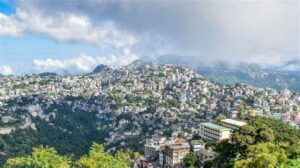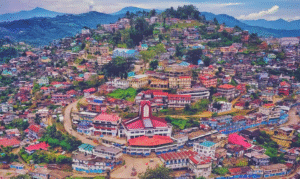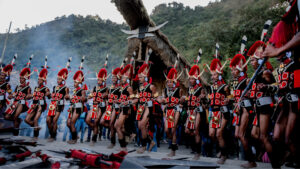Introduction
Kharchi Puja is one of the most prominent and spiritually significant festivals in the northeastern Indian state of Tripura. Rooted in ancient royal customs and tribal beliefs, it is a vibrant celebration of tradition, religion, and culture. The word “Kharchi” is derived from two Tripuri words: Khar, meaning sin, and chi, meaning cleaning. As such, Kharchi Puja is essentially a ritualistic cleansing or purifying of sins through the worship of the Chaturdasha Devata or the fourteen deities who are considered the protectors of the Tripuri people.
This festival, marked by elaborate rituals, traditional music, community feasting, and public devotion, reveals the unique religious blend of Hinduism and tribal animistic practices. It is not only a spiritual event but also a socio-cultural occasion that strengthens the identity of the Tripuri community.
Historical Background
The origins of Kharchi Puja can be traced back to the reign of the Manikya dynasty, which ruled the princely state of Tripura for centuries. The kings of Tripura practiced Hinduism but also retained a deep connection to the indigenous animistic practices of the region. The Chaturdasha Devata—fourteen deities representing aspects of nature, tribal belief, and Hindu divinity—were revered as the guardians of the land and people.
The official place of worship for these deities was the Chaturdasha Devata Mandir located in Old Agartala (Puran Haveli), the former capital of Tripura. The deities were typically kept covered and were worshipped in a sacred grove. However, during Kharchi Puja, these deities are brought out, bathed in the river, and ceremoniously worshipped in public. This annual festival came to reflect the blend of folk and formal religious traditions, rooted in a desire for divine cleansing, protection, and prosperity.
The Chaturdasha Devata – The Fourteen Deities
The central focus of Kharchi Puja is the worship of the Chaturdasha Devata. These deities are:
- Kali
- Shiva
- Durga
- Vishnu
- Lakshmi
- Saraswati
- Kartika
- Ganesh
- Brahma
- Samudra (Ocean)
- Agni (Fire)
- Kamadeva (God of Love)
- Himalaya
- Ganga (River Goddess)
While some of these deities are familiar pan-Indian gods, others represent elements of nature and regional belief systems, highlighting the syncretism of tribal and Vedic religious structures in Tripura.
Ritual Significance and Practices
Kharchi Puja is traditionally observed during the Shukla Paksha (waxing phase) of the month of Ashadha (June–July). The festival lasts for seven days, with the first day marked by the most important and sacred rituals.
1. Washing of the Deities
The most distinctive ritual of Kharchi Puja involves the ceremonial bathing of the fourteen deities. On the first day, the idols are taken from the sanctum of the temple to the nearby river Saidra, which is believed to be sacred. This symbolic act of bathing the gods signifies purification and the cleansing of sins. Devotees gather in large numbers to witness this divine procession.
2. Offering Rituals and Animal Sacrifices
After the bath, the deities are brought back to the temple, where traditional rituals are performed by royal priests. Offerings of fruits, flowers, sweets, and incense are made. In some traditional households, and as per customary tribal practices, animal sacrifices (typically goats or pigeons) may be performed, although this practice has come under ethical and religious scrutiny in recent times.
3. Folk Performances and Devotional Songs
Kharchi Puja is also accompanied by traditional Tripuri dances, folk music, and devotional songs (bhajans). Artists dressed in ethnic attire perform on temple grounds, invoking blessings and sharing stories from mythology and history.
4. Community Participation and Feasting
Another vital aspect of Kharchi Puja is the spirit of community bonding. People from all walks of life, irrespective of caste or religion, participate in the festivities. Devotees prepare community feasts, and food is offered to all visitors. This reinforces social cohesion and shared cultural identity.
The Role of the Royal Family
The royal family of Tripura, historically the Manikya dynasty, has always played a central role in Kharchi Puja. The rituals are led by priests designated by the royal household. Even after the merger of Tripura with the Indian Union in 1949 and the gradual decline of monarchy, the symbolic presence of the royal family continues to hold religious and cultural significance. Members of the former royal family are often seen inaugurating the ceremonies and attending key events.
Gender and Myth in Kharchi Puja
Kharchi Puja is also connected with the worship of Mother Earth and the feminine divine. According to local legends, the Earth goddess menstruates once a year, and during this time, the land becomes impure. Women also observe seclusion during this symbolic time. The Kharchi Puja is performed just after this period, serving as a cleansing and purification ritual, not just for the earth but also for society as a whole.
This element of the festival reflects the deeply rooted reverence for feminine power, fertility, and the cycles of nature, prominent in many indigenous cultures across the world. It also aligns with ancient Indian customs of Rajaswala Parva (worship during a woman’s menstruation), thereby offering anthropological insights into gender, purity, and the sacred.
Cultural and Social Impact
Kharchi Puja serves as a lens to understand Tripura’s diverse cultural matrix. It:
- Preserves tribal heritage: By maintaining the worship of the Chaturdasha Devata, the festival keeps alive indigenous belief systems that might otherwise fade in the face of modernity.
- Encourages religious harmony: The celebration includes elements of both tribal spirituality and Hindu theology, representing a rare blend that fosters unity.
- Promotes traditional arts: The festival is a platform for local artists, musicians, and dancers to showcase their talent and preserve oral traditions and folk customs.
- Strengthens tourism: With growing recognition, Kharchi Puja now attracts tourists and researchers from across India and abroad, thereby contributing to Tripura’s economy and cultural outreach.
Ecological and Ethical Concerns
While the festival is rooted in age-old practices, it is not without challenges in the modern context:
- Animal sacrifice is now debated on ethical and environmental grounds. While some groups defend it as tradition, others call for symbolic rituals.
- Waste management during large gatherings becomes critical, especially with food distribution, plastic use, and leftover offerings in rivers.
- River pollution from the ritual bathing of idols and offerings made into water bodies raises ecological concerns, necessitating sustainable alternatives.
There is a growing movement in Tripura to make Kharchi Puja more eco-friendly, ethical, and inclusive, without compromising its spiritual essence.
Kharchi Puja in Contemporary Times
Today, Kharchi Puja is both a religious celebration and a cultural festival. It is broadcast on local TV, covered widely in the media, and supported by the state government. Infrastructure like roads, lighting, and public facilities are improved temporarily around the temple premises during the festival week to accommodate the massive footfall.
In recent years, educational institutions and cultural organizations have also taken an active role in researching and promoting the significance of Kharchi Puja through seminars, exhibitions, and heritage walks. The participation of youth is particularly noticeable, ensuring continuity and relevance in future generations.
Academic Relevance and Interdisciplinary Perspectives
Kharchi Puja can be studied from multiple academic lenses:
- Anthropology: Offers insights into tribal belief systems, ritual symbolism, and the fusion of indigenous and mainstream religious practices.
- Religious Studies: Highlights the plurality of Hinduism and the sacred landscape of Northeast India.
- Sociology: Explores themes of community bonding, social stratification, gender roles, and modernization of tradition.
- History: Provides valuable data on Tripura’s dynastic history, royal patronage, and the evolution of festivals.
- Cultural Studies: Showcases oral traditions, folk arts, and linguistic diversity through the lens of a religious celebration.
Thus, Kharchi Puja serves as a rich cultural text for interdisciplinary academic research.
Conclusion
Kharchi Puja is more than a religious event; it is a living heritage that embodies the cultural, historical, and spiritual consciousness of the people of Tripura. Through its unique blend of tribal customs and Hindu rituals, it reflects the diverse yet harmonious ethos of the region. The worship of the fourteen deities, the cleansing rituals, the involvement of the royal family, and the community participation all come together to make Kharchi Puja a fascinating cultural phenomenon.
In a world where traditional practices are rapidly being forgotten or overshadowed, festivals like Kharchi Puja remind us of the importance of cultural preservation, respectful modernization, and inclusive celebration. It is an emblem of Tripura’s resilient identity and a tribute to the sacred bond between people, nature, and the divine.






